Multiscale Eulerian CFD of Chemical Processes: A Review
Abstract
1. Introduction
2. Eulerian CFD Models
2.1. Single-Phase Eulerian CFD Model
2.2. Gas-Liquid Eulerian CFD Model
2.3. Gas-Solid Eulerian CFD Model
2.4. Three-Phase Eulerian CFD Model
2.5. Turbulence Equations
3. Applications of Eulerian CFD
3.1. Single-Phase CFD Simulations
3.1.1. Gas Distributors
3.1.2. Gas-Filling Storage Processes
3.1.3. Fixed Bed with Random Packing
3.2. Gas-Liquid Phase CFD Simulations
3.2.1. Gas-Liquid Flow in Structured Packing
3.2.2. Gas-Liquid Flow in Random Packing
3.2.3. Gas-Liquid Bubble Columns
3.3. Gas-Solid Phase CFD Simulations
3.4. Gas-Liquid-Solid Phase CFD Simulations
3.5. Multiscale CFD Simulations
3.5.1. Concurrent Coupling Strategy
3.5.2. Sequential Coupling Strategy
4. Discussion of Multiscale CFD Simulations
4.1. Mesh Independency
4.2. Open Source Code
4.3. Digital Twins with CFD
5. Conclusions
Author Contributions
Funding
Acknowledgments
Conflicts of Interest
References
- Delgado-Buscalioni, R.; Coveney, P.V.; Riley, G.D.; Ford, R.W. Hybrid molecular-continuum fluid models: Implementation within a general coupling framework. Philos. Trans. R. Soc. A 2005, 363, 1975–1985. [Google Scholar] [CrossRef]
- Lim, Y.-I. State-of-arts in multiscale simulation for process development. Korean Chem. Eng. Res. 2013, 51, 10–24. [Google Scholar] [CrossRef][Green Version]
- Drikakis, D.; Frank, M.; Tabor, G. Multiscale computational fluid dynamics. Energies 2019, 12, 3272. [Google Scholar] [CrossRef]
- Weinan, E. Principles of Multiscale Modeling, 1st ed.; Cambridge University Press: New York, NY, USA, 2011. [Google Scholar]
- Mahian, O.; Kolsi, L.; Amani, M.; Estellé, P.; Ahmadi, G.; Kleinstreuer, C.; Marshall, J.S.; Taylor, R.A.; Abu-Nada, E.; Rashidi, S.; et al. Recent advances in modeling and simulation of nanofluid flows—Part II: Applications. Phys. Rep. 2019, 791, 1–59. [Google Scholar] [CrossRef]
- Braatz, R.D. Multiscale simulation in science and engineering. In Proceedings of the AIChE Annual Meeting, Nashville, TN, USA, 8–13 November 2009. [Google Scholar]
- Fermeglia, M.; Pricl, S. Multiscale molecular modeling in nanostructured material design and process system engineering. Comput. Chem. Eng. 2009, 33, 1701–1710. [Google Scholar] [CrossRef]
- Olsen, J.M.H.; Bolnykh, V.; Meloni, S.; Ippoliti, E.; Bircher, M.P.; Carloni, P.; Rothlisberger, U. MiMiC: A novel framework for multiscale modeling in computational chemistry. J. Chem. Theory Comput. 2019, 15, 3810–3823. [Google Scholar] [CrossRef] [PubMed]
- Ideker, T.; Galitski, T.; Hood, L. A new approach to decoding life: Systems biology. Annu. Rev. Genom. Hum. Genet. 2001, 2, 343–372. [Google Scholar] [CrossRef] [PubMed]
- Renardy, M.; Hult, C.; Evans, S.; Linderman, J.J.; Kirschner, D.E. Global sensitivity analysis of biological multiscale models. Curr. Opin. Biomed. Eng. 2019, 11, 109–116. [Google Scholar] [CrossRef]
- Durdagi, S.; Dogan, B.; Erol, I.; Kayık, G.; Aksoydan, B. Current status of multiscale simulations on GPCRs. Curr. Opin. Struct. Biol. 2019, 55, 93–103. [Google Scholar] [CrossRef]
- Koullapis, P.; Ollson, B.; Kassinos, S.C.; Sznitman, J. Multiscale in silico lung modeling strategies for aerosol inhalation therapy and drug delivery. Curr. Opin. Biomed. Eng. 2019, 11, 130–136. [Google Scholar] [CrossRef]
- Crose, M.; Tran, A.; Christofides, D.P. Multiscale computational fluid dynamics: Methodology and application to PECVD of thin film solar cells. Coatings 2017, 7, 22. [Google Scholar] [CrossRef]
- Raimondeau, S.; Vlachos, D.G. Recent developments on multiscale, hierarchical modeling of chemical reactors. Chem. Eng. J. 2002, 90, 3–23. [Google Scholar] [CrossRef]
- Tong, Z.-X.; He, Y.-L.; Tao, W.-Q. A review of current progress in multiscale simulations for fluid flow and heat transfer problems: The frameworks, coupling techniques and future perspectives. Int. J. Heat Mass Transf. 2019, 137, 1263–1289. [Google Scholar] [CrossRef]
- Vlachos, D.G. Multiscale modeling for emergent behavior, complexity, and combinatorial explosion. AIChE J. 2012, 58, 1314–1325. [Google Scholar] [CrossRef]
- Ge, W.; Chang, Q.; Li, C.; Wang, J. Multiscale structures in particle–fluid systems: Characterization, modeling, and simulation. Chem. Eng. Sci. 2019, 198, 198–223. [Google Scholar] [CrossRef]
- Mahian, O.; Kolsi, L.; Amani, M.; Estellé, P.; Ahmadi, G.; Kleinstreuer, C.; Marshall, J.S.; Siavashi, M.; Taylor, R.A.; Niazmand, H.; et al. Recent advances in modeling and simulation of nanofluid flows-Part I: Fundamentals and theory. Phys. Rep. 2019, 790, 1–48. [Google Scholar] [CrossRef]
- Chen, S.; Doolen, G.D. Lattice Boltzmann method for fluid flows. Annu. Rev. Fluid Mech. 1998, 30, 329–364. [Google Scholar] [CrossRef]
- Nourgaliev, R.R.; Dinh, T.N.; Theofanous, T.G.; Joseph, D. The lattice Boltzmann equation method: Theoretical interpretation, numerics and implications. Int. J. Multiph. Flow 2003, 29, 117–169. [Google Scholar] [CrossRef]
- Nguyen, T.D.B.; Seo, M.W.; Lim, Y.-I.; Song, B.-H.; Kim, S.-D. CFD simulation with experiments in a dual circulating fluidized bed gasifier. Comput. Chem. Eng. 2012, 36, 48–56. [Google Scholar] [CrossRef]
- Nguyen, D.D.; Ngo, S.I.; Lim, Y.-I.; Kim, W.; Lee, U.-D.; Seo, D.; Yoon, W.-L. Optimal design of a sleeve-type steam methane reforming reactor for hydrogen production from natural gas. Int. J. Hydrog. Energy 2019, 44, 1973–1987. [Google Scholar] [CrossRef]
- Pan, H.; Chen, X.-Z.; Liang, X.-F.; Zhu, L.-T.; Luo, Z.-H. CFD simulations of gas–liquid–solid flow in fluidized bed reactors—A review. Powder Technol. 2016, 299, 235–258. [Google Scholar] [CrossRef]
- Pham, H.H.; Lim, Y.-I.; Han, S.; Lim, B.; Ko, H.-S. Hydrodynamics and design of gas distributor in large-scale amine absorbers using computational fluid dynamics. Korean J. Chem. Eng. 2018, 35, 1073–1082. [Google Scholar] [CrossRef]
- Yang, N.; Xiao, Q. A mesoscale approach for population balance modeling of bubble size distribution in bubble column reactors. Chem. Eng. Sci. 2017, 170, 241–250. [Google Scholar] [CrossRef]
- Bourgeois, T.; Ammouri, F.; Baraldi, D.; Moretto, P. The temperature evolution in compressed gas filling processes: A review. Int. J. Hydrog. Energy 2018, 43, 2268–2292. [Google Scholar] [CrossRef]
- Raveh, D.E. Computational-fluid-dynamics-based aeroelastic analysis and structural design optimization—A researcher’s perspective. Comput. Methods Appl. Mech. Eng. 2005, 194, 3453–3471. [Google Scholar] [CrossRef]
- Pinto, G.; Silva, F.; Porteiro, J.; Míguez, J.; Baptista, A. Numerical simulation applied to PVD reactors: An overview. Coatings 2018, 8, 410. [Google Scholar] [CrossRef]
- Ngo, S.I.; Lim, Y.-I.; Hahn, M.-H.; Jung, J.; Bang, Y.-H. Multi-scale computational fluid dynamics of impregnation die for thermoplastic carbon fiber prepreg production. Comput. Chem. Eng. 2017, 103, 58–68. [Google Scholar] [CrossRef]
- Lakehal, D. Status and future developments of Large-Eddy Simulation of turbulent multi-fluid flows (LEIS and LESS). Int. J. Multiph. Flow 2018, 104, 322–337. [Google Scholar] [CrossRef]
- Xiao, H.; Cinnella, P. Quantification of model uncertainty in RANS simulations: A review. Prog. Aerosp. Sci. 2019, 108, 1–31. [Google Scholar] [CrossRef]
- Klein, M.; Ketterl, S.; Hasslberger, J. Large eddy simulation of multiphase flows using the volume of fluid method: Part 1—Governing equations and a priori analysis. Exp. Comput. Multiph. Flow 2019, 1, 130–144. [Google Scholar] [CrossRef]
- Ngo, S.I.; Lim, Y.-I.; Hahn, M.-H.; Jung, J. Prediction of degree of impregnation in thermoplastic unidirectional carbon fiber prepreg by multi-scale computational fluid dynamics. Chem. Eng. Sci. 2018, 185, 64–75. [Google Scholar] [CrossRef]
- da Rosa, C.A.; Braatz, R.D. Multiscale modeling and simulation of macromixing, micromixing, and crystal size distribution in radial mixers/crystallizers. Ind. Eng. Chem. Res. 2018, 57, 5433–5441. [Google Scholar] [CrossRef]
- Haghighat, A.; Luxbacher, K.; Lattimer, B.Y. Development of a methodology for interface boundary selection in the multiscale road tunnel fire simulations. Fire Technol. 2018, 54, 1029–1066. [Google Scholar] [CrossRef]
- Höhne, T.; Krepper, E.; Lucas, D.; Montoya, G. A multiscale approach simulating boiling in a heated pipe including flow pattern transition. Nucl. Technol. 2019, 205, 48–56. [Google Scholar] [CrossRef]
- Uribe, S.; Cordero, M.E.; Reyes, E.P.; Regalado-Méndez, A.; Zárate, L.G. Multiscale CFD modelling and analysis of TBR behavior for an HDS process: Deviations from ideal behaviors. Fuel 2019, 239, 1162–1172. [Google Scholar] [CrossRef]
- Ferreira, R.B.; Falcão, D.S.; Oliveira, V.B.; Pinto, A.M.F.R. Numerical simulations of two-phase flow in proton exchange membrane fuel cells using the volume of fluid method—A review. J. Power Sources 2015, 277, 329–342. [Google Scholar] [CrossRef]
- Karpinska, A.M.; Bridgeman, J. CFD-aided modelling of activated sludge systems—A critical review. Water Res. 2016, 88, 861–879. [Google Scholar] [CrossRef]
- Sharma, S.K.; Kalamkar, V.R. Computational fluid dynamics approach in thermo-hydraulic analysis of flow in ducts with rib roughened walls—A review. Renew. Sustain. Energy Rev. 2016, 55, 756–788. [Google Scholar] [CrossRef]
- Yin, C.; Yan, J. Oxy-fuel combustion of pulverized fuels: Combustion fundamentals and modeling. Appl. Energy 2016, 162, 742–762. [Google Scholar] [CrossRef]
- Uebel, K.; Rößger, P.; Prüfert, U.; Richter, A.; Meyer, B. CFD-based multi-objective optimization of a quench reactor design. Fuel Process. Technol. 2016, 149, 290–304. [Google Scholar] [CrossRef]
- Fotovat, F.; Bi, X.T.; Grace, J.R. Electrostatics in gas-solid fluidized beds: A review. Chem. Eng. Sci. 2017, 173, 303–334. [Google Scholar] [CrossRef]
- Pires, J.C.M.; Alvim-Ferraz, M.C.M.; Martins, F.G. Photobioreactor design for microalgae production through computational fluid dynamics: A review. Renew. Sustain. Energy Rev. 2017, 79, 248–254. [Google Scholar] [CrossRef]
- Malekjani, N.; Jafari, S.M. Simulation of food drying processes by Computational Fluid Dynamics (CFD); recent advances and approaches. Trends Food Sci. Technol. 2018, 78, 206–223. [Google Scholar] [CrossRef]
- Lu, B.; Niu, Y.; Chen, F.; Ahmad, N.; Wang, W.; Li, J. Energy-minimization multiscale based mesoscale modeling and applications in gas-fluidized catalytic reactors. Rev. Chem. Eng. 2019. [Google Scholar] [CrossRef]
- Wang, J. Continuum theory for dense gas-solid flow: A state-of-the-art review. Chem. Eng. Sci. 2020, 215, 115428. [Google Scholar] [CrossRef]
- Pham, H.H.; Lim, Y.-I.; Ngo, S.I.; Bang, Y.-H. Computational fluid dynamics and tar formation in a low-temperature carbonization furnace for the production of carbon fibers. J. Ind. Eng. Chem. 2019, 73, 286–296. [Google Scholar] [CrossRef]
- Farias, L.F.I.; de Souza, J.A.; Braatz, R.D.; da Rosa, C.A. Coupling of the population balance equation into a two-phase model for the simulation of combined cooling and antisolvent crystallization using OpenFOAM. Comput. Chem. Eng. 2019, 123, 246–256. [Google Scholar] [CrossRef]
- Ngo, S.I.; Lim, Y.-I.; Kim, S.-C. Wave characteristics of coagulation bath in dry-jet wet-spinning process for polyacrylonitrile fiber production using computational fluid dynamics. Processes 2019, 7, 314. [Google Scholar] [CrossRef]
- Wu, B.; Firouzi, M.; Mitchell, T.; Rufford, T.E.; Leonardi, C.; Towler, B. A critical review of flow maps for gas-liquid flows in vertical pipes and annuli. Chem. Eng. J. 2017, 326, 350–377. [Google Scholar] [CrossRef]
- Bhole, M.R.; Joshi, J.B.; Ramkrishna, D. CFD simulation of bubble columns incorporating population balance modeling. Chem. Eng. Sci. 2008, 63, 2267–2282. [Google Scholar] [CrossRef]
- Tran, B.V.; Nguyen, D.D.; Ngo, S.I.; Lim, Y.-I.; Kim, B.; Lee, D.H.; Go, K.-S.; Nho, N.-S. Hydrodynamics and simulation of air–water homogeneous bubble column under elevated pressure. AIChE J. 2019, 65, e16685. [Google Scholar] [CrossRef]
- Pham, D.A.; Lim, Y.-I.; Jee, H.; Ahn, E.; Jung, Y. Porous media Eulerian computational fluid dynamics (CFD) model of amine absorber with structured-packing for CO2 removal. Chem. Eng. Sci. 2015, 132, 259–270. [Google Scholar] [CrossRef]
- Ngo, S.I.; Lim, Y.-I.; Song, B.-H.; Lee, U.-D.; Lee, J.-W.; Song, J.-H. Effects of fluidization velocity on solid stack volume in a bubbling fluidized-bed with nozzle-type distributor. Powder Technol. 2015, 275, 188–198. [Google Scholar] [CrossRef]
- Ngo, S.I.; Lim, Y.-I.; Song, B.-H.; Lee, U.-D.; Yang, C.-W.; Choi, Y.-T.; Song, J.-H. Hydrodynamics of cold-rig biomass gasifier using semi-dual fluidized-bed. Powder Technol. 2013, 234, 97–106. [Google Scholar] [CrossRef]
- Sun, L.; Luo, K.; Fan, J. Numerical investigation on methanation kinetic and flow behavior in full-loop fluidized bed reactor. Fuel 2018, 231, 85–93. [Google Scholar] [CrossRef]
- Zhou, Q.; Wang, J. CFD study of mixing and segregation in CFB risers: Extension of EMMS drag model to binary gas–solid flow. Chem. Eng. Sci. 2015, 122, 637–651. [Google Scholar] [CrossRef]
- Gidaspow, D. Multiphase Flow and Fluidization: Continuum and Kinetic Theory Description; Academic Press: Cambridge, MA, USA, 1994. [Google Scholar]
- Lun, C.K.K.; Savage, S.B.; Jeffrey, D.J.; Chepurniy, N. Kinetic theories for granular flow: Inelastic particles in Couette flow and slightly inelastic particles in a general flowfield. J. Fluid Mech. 1984, 140, 223–256. [Google Scholar] [CrossRef]
- Syamlal, M.; Rogers, W.; O’Brien, T.J. MFIX Documentation: Volume1, Theory Guide; National Technical Information Service: Springfield, VA, USA, 1993. [Google Scholar]
- Schaeffer, D.G. Instability in the evolution equations describing incompressible granular flow. J. Differ. Equ. 1987, 66, 19–50. [Google Scholar] [CrossRef]
- Ogawa, S.; Umemura, A.; Oshima, N. On the equations of fully fluidized granular materials. Z. Angew. Math. Phys. ZAMP 1980, 31, 483–493. [Google Scholar] [CrossRef]
- Ge, W.; Wang, W.; Yang, N.; Li, J.; Kwauk, M.; Chen, F.; Chen, J.; Fang, X.; Guo, L.; He, X.; et al. Meso-scale oriented simulation towards virtual process engineering (VPE)-The EMMS Paradigm. Chem. Eng. Sci. 2011, 66, 4426–4458. [Google Scholar] [CrossRef]
- Hamidipour, M.; Chen, J.; Larachi, F. CFD study on hydrodynamics in three-phase fluidized beds—Application of turbulence models and experimental validation. Chem. Eng. Sci. 2012, 78, 167–180. [Google Scholar] [CrossRef]
- Hosseini, S.H.; Shojaee, S.; Ahmadi, G.; Zivdar, M. Computational fluid dynamics studies of dry and wet pressure drops in structured packings. J. Ind. Eng. Chem. 2012, 18, 1465–1473. [Google Scholar] [CrossRef]
- Nguyen, T.D.B.; Lim, Y.-I.; Kim, S.-J.; Eom, W.-H.; Yoo, K.-S. Experiment and Computational Fluid Dynamics (cfd) simulation of urea-based Selective Noncatalytic Reduction (SNCR) in a pilot-scale flow reactor. Energy Fuels 2008, 22, 3864–3876. [Google Scholar] [CrossRef]
- Ngo, S.I.; Lim, Y.-I.; Kim, W.; Seo, D.J.; Yoon, W.L. Computational fluid dynamics and experimental validation of a compact steam methane reformer for hydrogen production from natural gas. Appl. Energy 2019, 236, 340–353. [Google Scholar] [CrossRef]
- Rzehak, R.; Krauß, M.; Kováts, P.; Zähringer, K. Fluid dynamics in a bubble column: New experiments and simulations. Int. J. Multiph. Flow 2017, 89, 299–312. [Google Scholar] [CrossRef]
- Ramos, A.; Monteiro, E.; Rouboa, A. Numerical approaches and comprehensive models for gasification process: A review. Renew. Sustain. Energy Rev. 2019, 110, 188–206. [Google Scholar] [CrossRef]
- Kone, J.-P.; Zhang, X.; Yan, Y.; Hu, G.; Ahmadi, G. CFD modeling and simulation of PEM fuel cell using OpenFOAM. Energy Procedia 2018, 145, 64–69. [Google Scholar] [CrossRef]
- Ahmadi, S.; Sefidvash, F. Study of pressure drop in fixed bed reactor using a Computational Fluid Dynamics (CFD) code. Chem. Eng. 2018, 2, 14. [Google Scholar]
- Wang, J.-Q.; Ouyang, Y.; Li, W.-L.; Esmaeili, A.; Xiang, Y.; Chen, J.-F. CFD analysis of gas flow characteristics in a rotating packed bed with randomly arranged spherical packing. Chem. Eng. J. 2020, 385, 123812. [Google Scholar] [CrossRef]
- Kang, J.-L.; Ciou, Y.-C.; Lin, D.-Y.; Wong, D.S.-H.; Jang, S.-S. Investigation of hydrodynamic behavior in random packing using CFD simulation. Chem. Eng. Res. Des. 2019, 147, 43–54. [Google Scholar] [CrossRef]
- Kim, J.; Pham, D.A.; Lim, Y.-I. Effect of gravity center position on amine absorber with structured packing under offshore operation: Computational fluid dynamics approach. Chem. Eng. Res. Des. 2017, 121, 99–112. [Google Scholar] [CrossRef]
- Soman, A.; Shastri, Y. Optimization of novel photobioreactor design using computational fluid dynamics. Appl. Energy 2015, 140, 246–255. [Google Scholar] [CrossRef]
- Le, T.T.; Ngo, S.I.; Lim, Y.-I.; Park, C.-K.; Lee, B.-D.; Kim, B.-G.; Lim, D.-H. Effect of simultaneous three-angular motion on the performance of an air–water–oil separator under offshore operation. Ocean Eng. 2019, 171, 469–484. [Google Scholar] [CrossRef]
- Fletcher, D.F.; McClure, D.D.; Kavanagh, J.M.; Barton, G.W. CFD simulation of industrial bubble columns: Numerical challenges and model validation successes. Appl. Math. Model. 2017, 44, 25–42. [Google Scholar] [CrossRef]
- Sharma, S.L.; Ishii, M.; Hibiki, T.; Schlegel, J.P.; Liu, Y.; Buchanan, J.R. Beyond bubbly two-phase flow investigation using a CFD three-field two-fluid model. Int. J. Multiph. Flow 2019, 113, 1–15. [Google Scholar] [CrossRef]
- Yan, P.; Jin, H.; He, G.; Guo, X.; Ma, L.; Yang, S.; Zhang, R. CFD simulation of hydrodynamics in a high-pressure bubble column using three optimized drag models of bubble swarm. Chem. Eng. Sci. 2019, 199, 137–155. [Google Scholar] [CrossRef]
- Thakare, H.R.; Monde, A.; Parekh, A.D. Experimental, computational and optimization studies of temperature separation and flow physics of vortex tube: A review. Renew. Sustain. Energy Rev. 2015, 52, 1043–1071. [Google Scholar] [CrossRef]
- Yang, X.; Yu, H.; Wang, R.; Fane, A.G. Optimization of microstructured hollow fiber design for membrane distillation applications using CFD modeling. J. Membr. Sci. 2012, 421–422, 258–270. [Google Scholar] [CrossRef]
- Minea, A.A.; Murshed, S.M.S. A review on development of ionic liquid based nanofluids and their heat transfer behavior. Renew. Sustain. Energy Rev. 2018, 91, 584–599. [Google Scholar] [CrossRef]
- Pham, H.H. Performance Evaluation of Low Temperature Furnace and Gas Distributors Using Computational Fluid Dynamics (CFD). Master Thesis, Hankyong National University, Anseong, Korea, 2018. [Google Scholar]
- Kim, J.; Pham, D.A.; Lim, Y.-I. Gas−liquid multiphase computational fluid dynamics (CFD) of amine absorption column with structured-packing for CO2 capture. Comput. Chem. Eng. 2016, 88, 39–49. [Google Scholar] [CrossRef]
- Zhang, G.; Jiao, K. Multi-phase models for water and thermal management of proton exchange membrane fuel cell: A review. J. Power Sources 2018, 391, 120–133. [Google Scholar] [CrossRef]
- Li, W.-L.; Ouyang, Y.; Gao, X.-Y.; Wang, C.-Y.; Shao, L.; Xiang, Y. CFD analysis of gas–liquid flow characteristics in a microporous tube-in-tube microchannel reactor. Comput. Fluids 2018, 170, 13–23. [Google Scholar] [CrossRef]
- Bhusare, V.H.; Dhiman, M.K.; Kalaga, D.V.; Roy, S.; Joshi, J.B. CFD simulations of a bubble column with and without internals by using OpenFOAM. Chem. Eng. J. 2017, 317, 157–174. [Google Scholar] [CrossRef]
- Behkish, A.; Lemoine, R.; Sehabiague, L.; Oukaci, R.; Morsi, B.I. Gas holdup and bubble size behavior in a large-scale slurry bubble column reactor operating with an organic liquid under elevated pressures and temperatures. Chem. Eng. J. 2007, 128, 69–84. [Google Scholar] [CrossRef]
- Zhang, H.; Yang, G.; Sayyar, A.; Wang, T. An improved bubble breakup model in turbulent flow. Chem. Eng. J. 2019. [Google Scholar] [CrossRef]
- Abdelmotalib, H.M.; Youssef, M.A.M.; Hassan, A.A.; Youn, S.B.; Im, I.-T. Heat transfer process in gas–solid fluidized bed combustors: A review. Int. J. Heat Mass Transf. 2015, 89, 567–575. [Google Scholar] [CrossRef]
- Wu, Y.; Shi, X.; Liu, Y.; Wang, C.; Gao, J.; Lan, X. 3D CPFD simulations of gas-solids flow in a CFB downer with cluster-based drag model. Powder Technol. 2019. [Google Scholar] [CrossRef]
- Banerjee, S.; Agarwal, R.K. Computational fluid dynamics modeling and simulations of fluidized beds for chemical looping combustion. In Handbook of Chemical Looping Technology; Breault, R.W., Ed.; Wiley-VCH: Weinheim, Germany, 2020; pp. 303–332. [Google Scholar] [CrossRef]
- Andrews, M.J.; O’Rourke, P.J. The multiphase particle-in-cell (MP-PIC) method for dense particulate flows. Int. J. Multiph. Flow 1996, 22, 379–402. [Google Scholar] [CrossRef]
- Snider, D.M.; Clark, S.M.; O’Rourke, P.J. Eulerian–Lagrangian method for three-dimensional thermal reacting flow with application to coal gasifiers. Chem. Eng. Sci. 2011, 66, 1285–1295. [Google Scholar] [CrossRef]
- Kim, S.H.; Lee, J.H.; Braatz, R.D. Multi-phase particle-in-cell coupled with population balance equation (MP-PIC-PBE) method for multiscale computational fluid dynamics simulation. Comput. Chem. Eng. 2020, 134, 106686. [Google Scholar] [CrossRef]
- Li, Y.; Yang, G.Q.; Zhang, J.P.; Fan, L.S. Numerical studies of bubble formation dynamics in gas–liquid–solid fluidization at high pressures. Powder Technol. 2001, 116, 246–260. [Google Scholar] [CrossRef]
- Chen, L.; Feng, Y.-L.; Song, C.-X.; Chen, L.; He, Y.-L.; Tao, W.-Q. Multi-scale modeling of proton exchange membrane fuel cell by coupling finite volume method and lattice Boltzmann method. Int. J. Heat Mass Transf. 2013, 63, 268–283. [Google Scholar] [CrossRef]
- Pozzetti, G.; Peters, B. A multiscale DEM-VOF method for the simulation of three-phase flows. Int. J. Multiph. Flow 2018, 99, 186–204. [Google Scholar] [CrossRef]
- Qi, H.; Li, F.; Xi, B.; You, C. Modeling of drag with the Eulerian approach and EMMS theory for heterogeneous dense gas-solid two-phase flow. Chem. Eng. Sci. 2007, 62, 1670–1681. [Google Scholar] [CrossRef]
- Raynal, L.; Royon-Lebeaud, A. A multi-scale approach for CFD calculations of gas–liquid flow within large size column equipped with structured packing. Chem. Eng. Sci. 2007, 62, 7196–7204. [Google Scholar] [CrossRef]
- Qi, W.; Guo, K.; Liu, C.; Liu, H.; Liu, B. Liquid distribution and local hydrodynamics of winpak: A multiscale method. Ind. Eng. Chem. Res. 2017, 56, 15184–15194. [Google Scholar] [CrossRef]
- Gao, X.; Li, T.; Sarkar, A.; Lu, L.; Rogers, W.A. Development and validation of an enhanced filtered drag model for simulating gas-solid fluidization of Geldart A particles in all flow regimes. Chem. Eng. Sci. 2018, 184, 33–51. [Google Scholar] [CrossRef]
- Lu, B.; Wang, W.; Li, J. Searching for a mesh-independent sub-grid model for CFD simulation of gas–solid riser flows. Chem. Eng. Sci. 2009, 64, 3437–3447. [Google Scholar] [CrossRef]
- Wang, W.; Li, J. Simulation of gas–solid two-phase flow by a multi-scale CFD approach—Of the EMMS model to the sub-grid level. Chem. Eng. Sci. 2007, 62, 208–231. [Google Scholar] [CrossRef]
- Bernaschi, M.; Melchionna, S.; Succi, S.; Fyta, M.; Kaxiras, E.; Sircar, J.K. MUPHY: A parallel MUlti PHYsics/scale code for high performance bio-fluidic simulations. Comput. Phys. Commun. 2009, 180, 1495–1502. [Google Scholar] [CrossRef]
- Tang, Y.-H.; Kudo, S.; Bian, X.; Li, Z.; Karniadakis, G.E. Multiscale universal interface: A concurrent framework for coupling heterogeneous solvers. J. Comput. Phys. 2015, 297, 13–31. [Google Scholar] [CrossRef]
- Neumann, P.; Flohr, H.; Arora, R.; Jarmatz, P.; Tchipev, N.; Bungartz, H.-J. MaMiCo: Software design for parallel molecular-continuum flow simulations. Comput. Phys. Commun. 2016, 200, 324–335. [Google Scholar] [CrossRef]
- Neumann, P.; Bian, X. MaMiCo: Transient multi-instance molecular-continuum flow simulation on supercomputers. Comput. Phys. Commun. 2017, 220, 390–402. [Google Scholar] [CrossRef]
- Li, L.; Li, B.; Liu, Z. Modeling of spout-fluidized beds and investigation of drag closures using OpenFOAM. Powder Technol. 2017, 305, 364–376. [Google Scholar] [CrossRef]
- Lu, Y.; Liu, C.; Wang, K.I.K.; Huang, H.; Xu, X. Digital twin-driven smart manufacturing: Connotation, reference model, applications and research issues. Robot. Comput. Integr. Manuf. 2020, 61, 101837. [Google Scholar] [CrossRef]
- Negri, E.; Fumagalli, L.; Macchi, M. A review of the roles of digital twin in CPS-based production systems. Procedia Manuf. 2017, 11, 939–948. [Google Scholar] [CrossRef]
- Katz, A.; Sankaran, V. Mesh quality effects on the accuracy of CFD solutions on unstructured meshes. J. Comput. Phys. 2011, 230, 7670–7686. [Google Scholar] [CrossRef]
- Roache, P.J. Perspective: A method for uniform reporting of grid refinement studies. J. Fluids Eng. 1994, 116, 405–413. [Google Scholar] [CrossRef]
- Roache, P.J. Verification of codes and calculations. AIAA J. 1998, 36, 696–702. [Google Scholar] [CrossRef]
- Owens, S.A.; Perkins, M.R.; Eldridge, R.B.; Schulz, K.W.; Ketcham, R.A. Computational fluid dynamics simulation of structured packing. Ind. Eng. Chem. Res. 2013, 52, 2032–2045. [Google Scholar] [CrossRef]
- Cloete, S.; Johansen, S.T.; Amini, S. Grid independence behaviour of fluidized bed reactor simulations using the two fluid model: Detailed parametric study. Powder Technol. 2016, 289, 65–70. [Google Scholar] [CrossRef]
- Liu, Q.; Gómez, F.; Pérez, J.M.; Theofilis, V. Instability and sensitivity analysis of flows using OpenFOAM®. Chin. J. Aeronaut. 2016, 29, 316–325. [Google Scholar] [CrossRef]
- Wang, J.-X.; Xiao, H. Data-driven CFD modeling of turbulent flows through complex structures. Int. J. Heat Fluid Flow 2016, 62, 138–149. [Google Scholar] [CrossRef][Green Version]
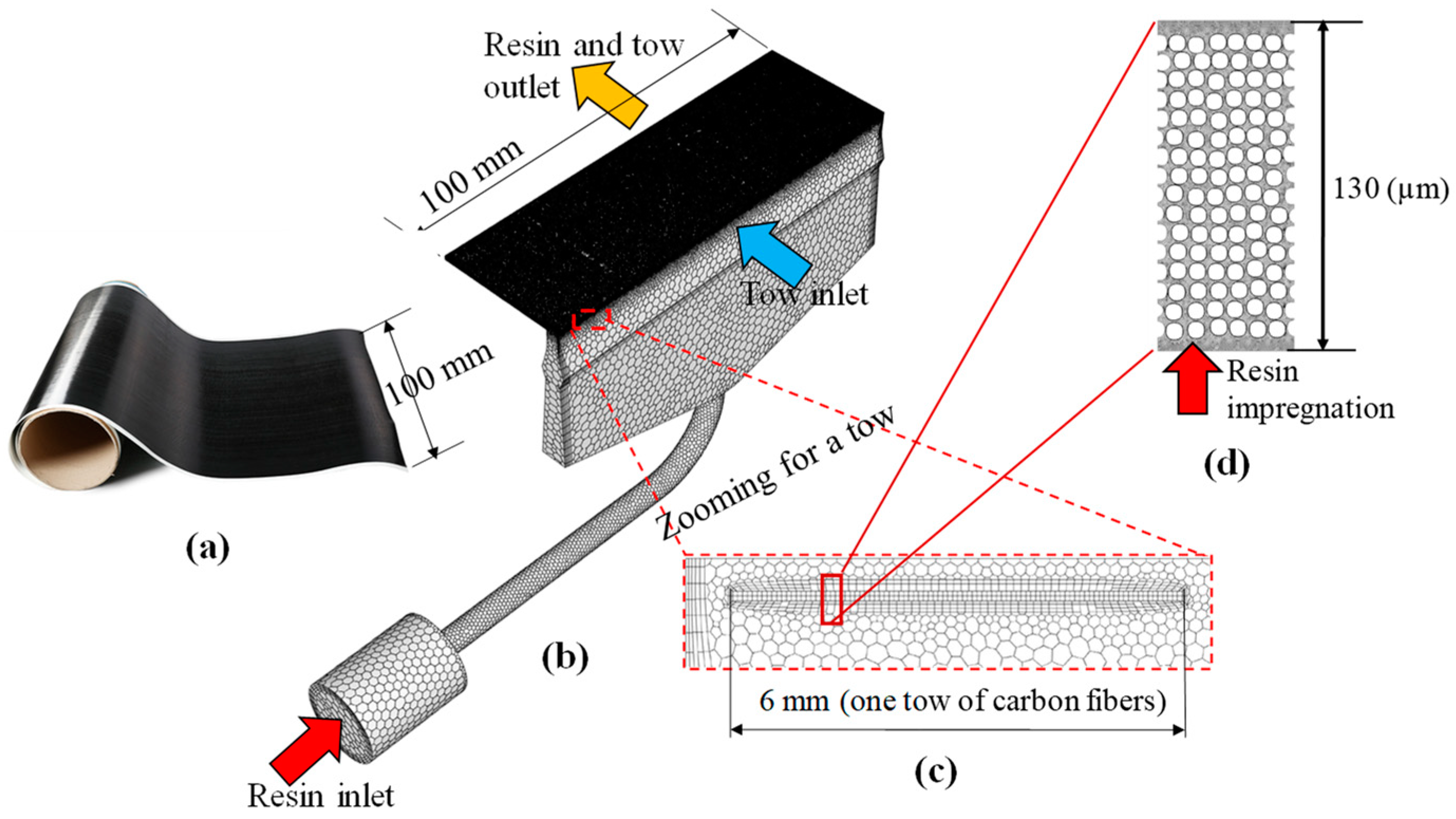
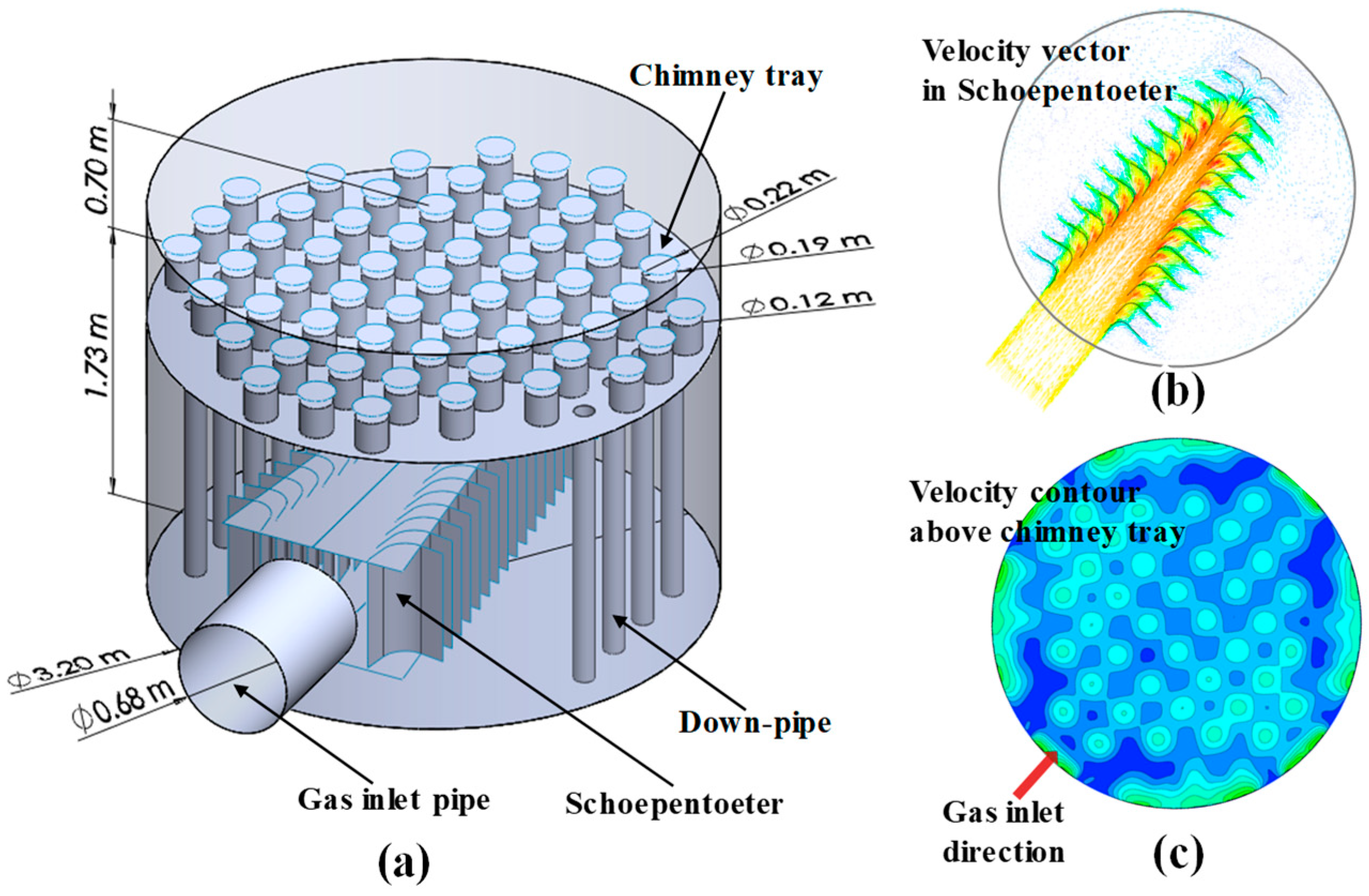
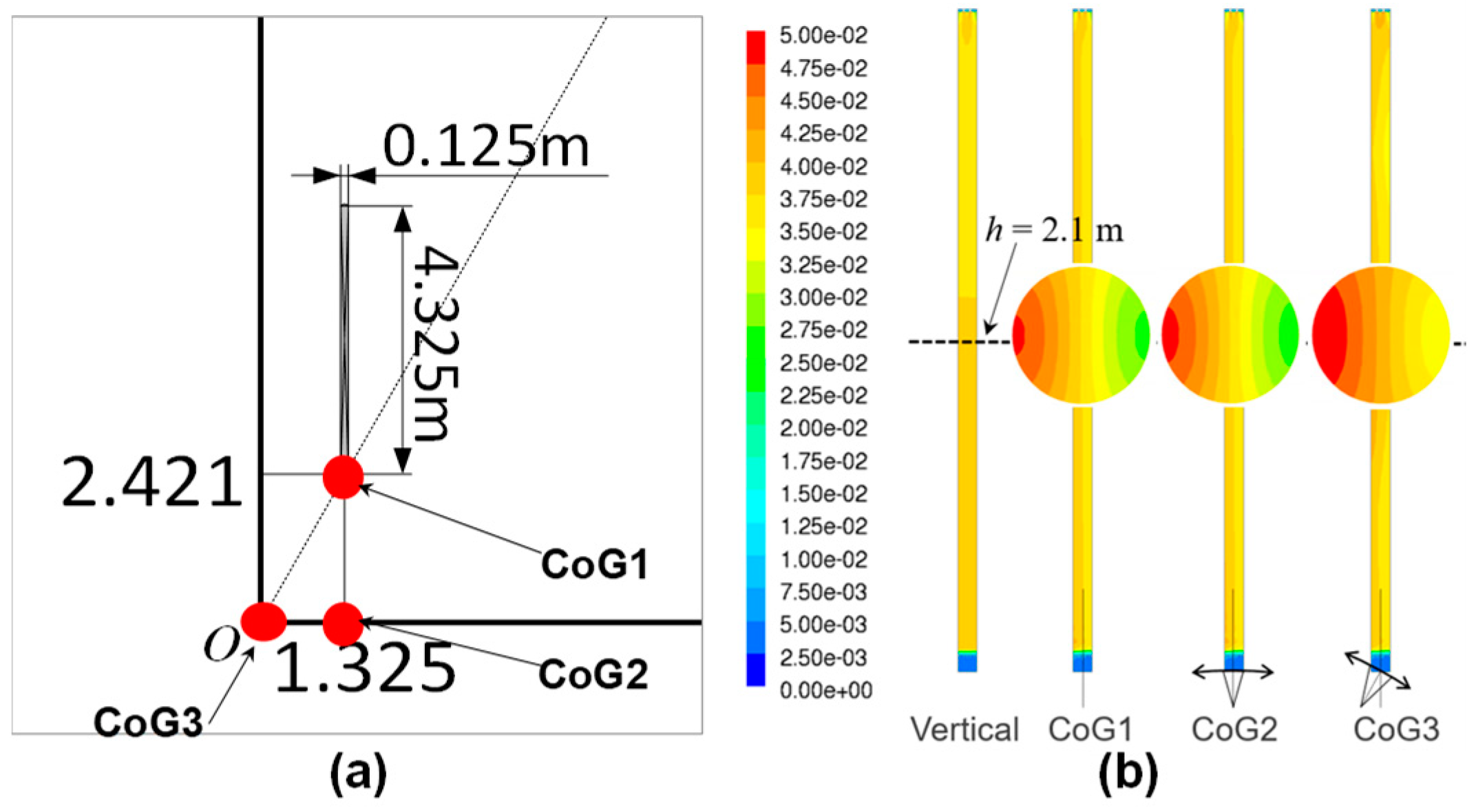
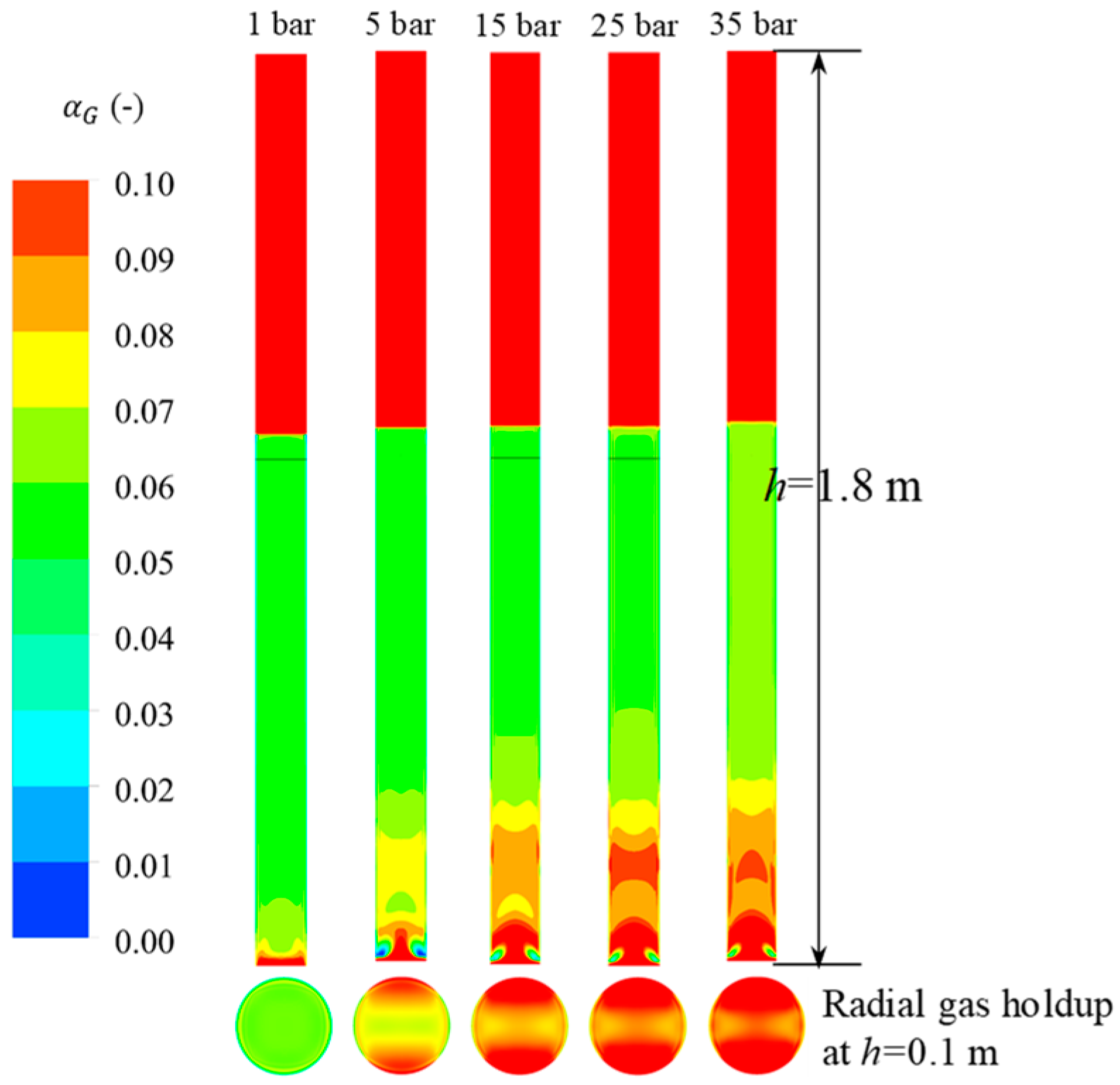
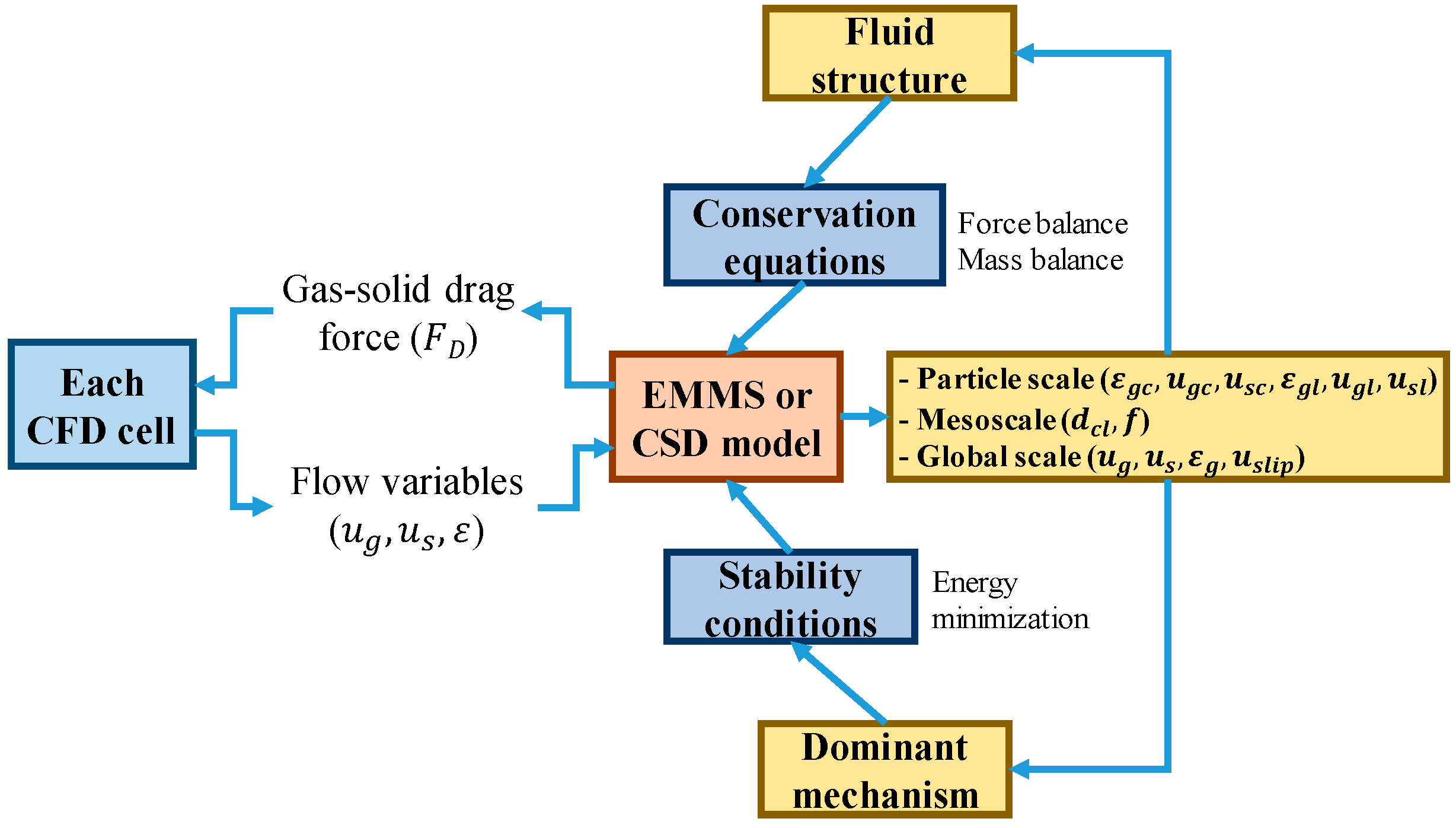
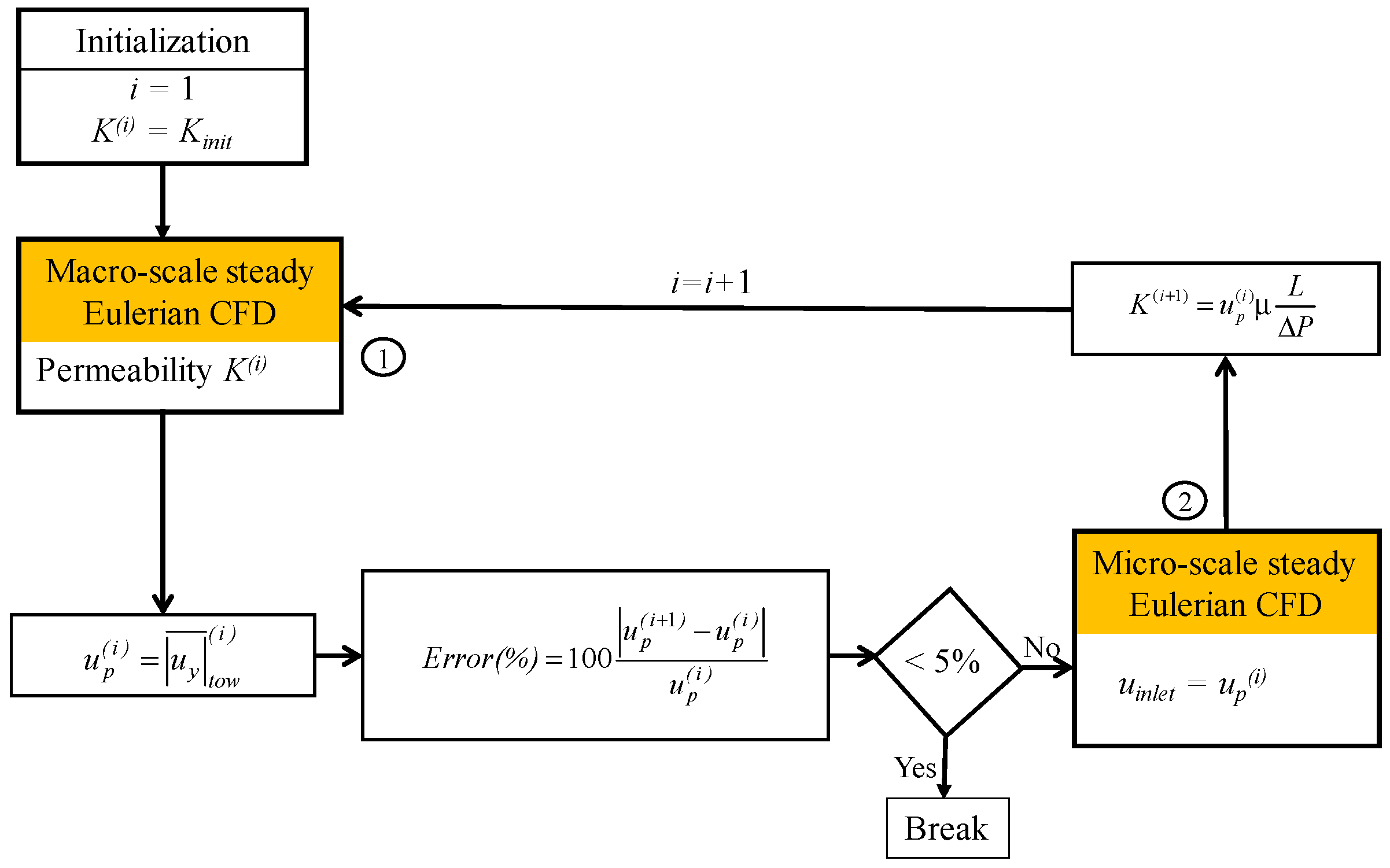
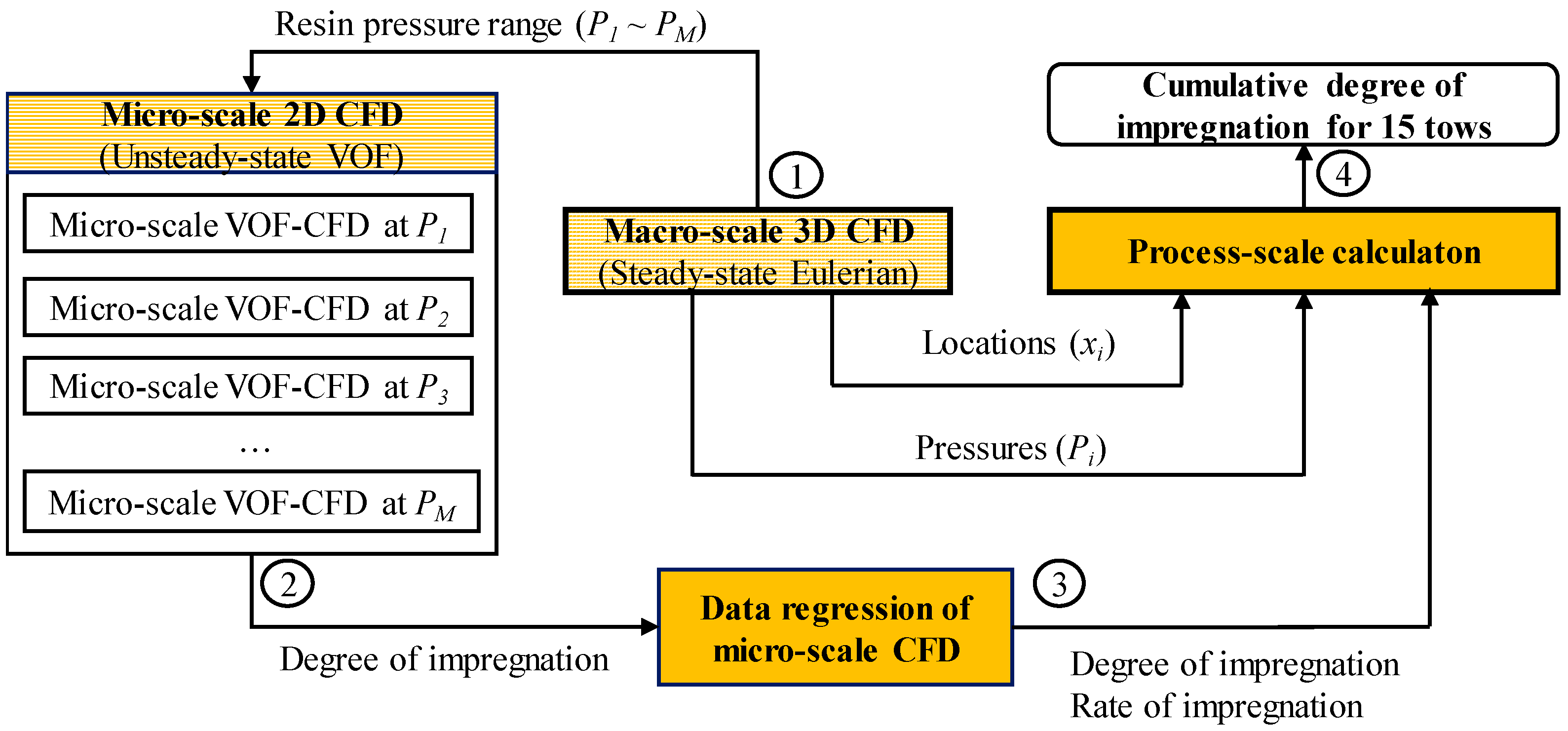
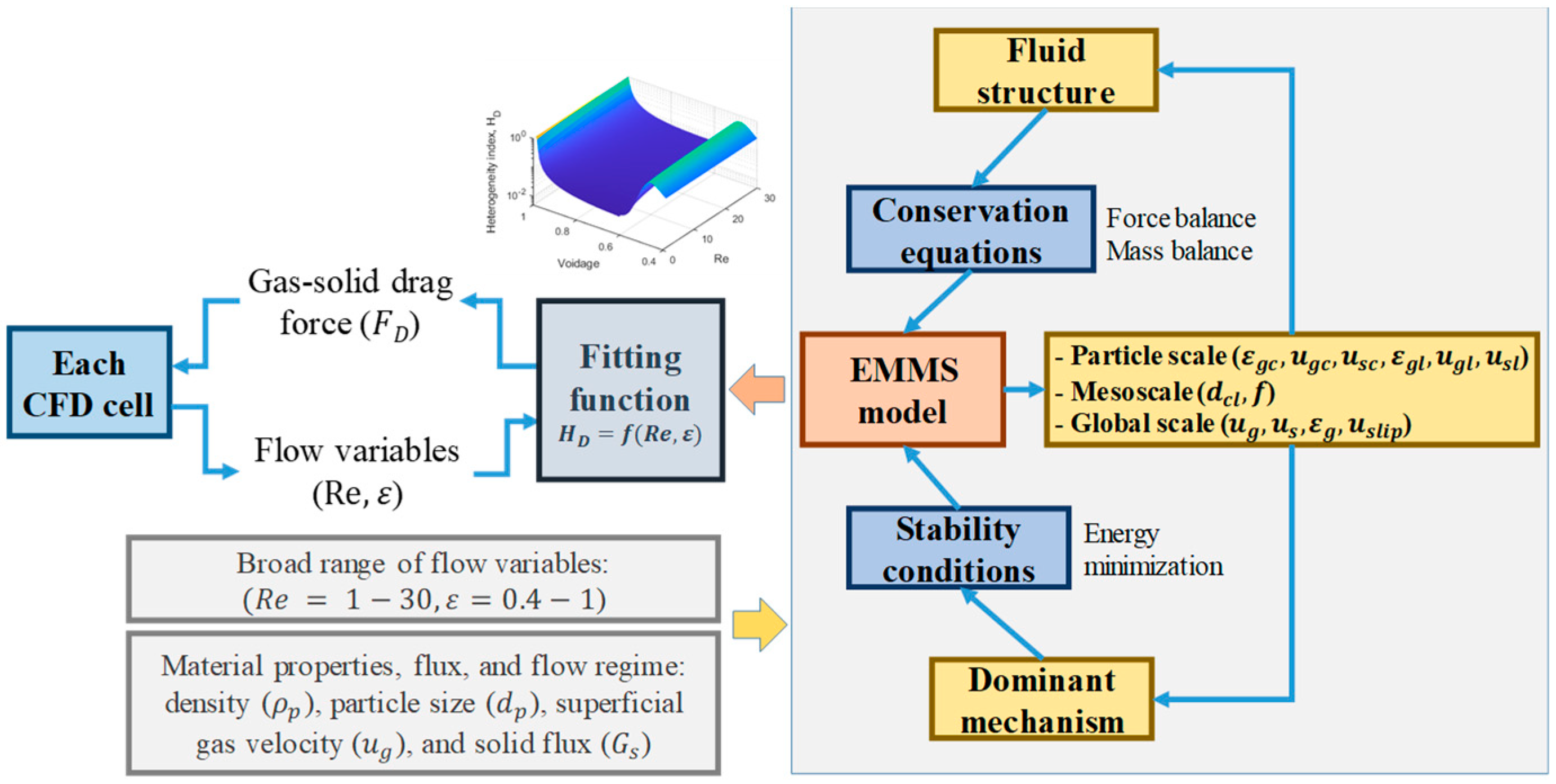
| Continuity equation: | (T1-1) | |
| Momentum equation: | where | (T1-2) |
| Energy equation: | (T1-3) |
| Continuity equation: | (T2-1) |
| Volume fraction equation: where the sharpening velocity () is and | (T2-2) |
| Momentum equation: | (T2-3) |
| where the surface tension force is | (T2-4) |
| with the surface stress tensor of | (T2-5) |
| Energy equation: | (T2-6) |
| Single properties (density): | (T2-7) |
| (viscosity): (conductivity): (energy): | (T2-8) (T2-9) (T2-10) |
| Continuity equation: | (T3-1) | |
| Momentum equation: | where , , | (T3-2) |
| , | (T3-3) | |
| , | (T3-4) | |
| , | (T3-5) | |
| , | (T3-6) | |
| and | (T3-7) | |
| Energy equation: | (T3-8) | |
| (T3-9) | ||
| Continuity equation (gas phase): (solid phase): | (T4-1) |
| Momentum equation (gas phase): (solid phase): | (T4-2) |
| where the solid-gas drag [59] is , when (dilute), with , when (dense), | (T4-3) |
| the gas-phase stress tensor is , | (T4-4) |
| the solid-phase stress tensor is , | (T4-5) |
| the solid-phase pressure is , | (T4-6) |
| the solid-phase bulk viscosity [60] is , | (T4-7) |
| the solid shear viscosity is , | (T4-8) |
| the collision viscosity of solids [61] is , | (T4-9) |
| the kinetic viscosity of solids [59] is , | (T4-10) |
| the frictional viscosity of solids [62] is ; with , | (T4-11) |
| and the radial distribution function [63] is with the maximum packing () | (T4-12) |
| Granular temperature () equation neglecting the convection and diffusion terms: | (T4-13) |
| where the energy generation by the solid stress tensor () with a double inner product is , | (T4-14) |
| the energy collisional dissipation rate of the solid phase [60] is , | (T4-15) |
| and the fluctuation kinetic energy transfer from the solid to gas phase [59] is | (T4-16) |
| Energy equation: | (T4-17) |
| (T4-18) |
| Continuity equation (gas phase): (liquid phase): (solid phase): | (T5-1) |
| Momentum equation (gas phase): (liquid phase): (solid phase): | (T5-2) |
| Interface interactions (G-L): (S-L): (G-S): | (T5-3) |
| Energy equation (gas phase): (liquid phase): (solid phase): | (T5-4) |
| Advantage | Disadvantage | Author | Models | Application Field | |
|---|---|---|---|---|---|
| Concurrent coupling | High accuracy | High computational cost | Chen, 2013 [98] | LBM-CFD | PEM fuel cell |
| Crose, 2017 [13] | KMC-CFD | PECVD wafer | |||
| Pozzetti, 2018 [99] | DEM-VOF | Three-phase flows with particles | |||
| Da Rosa, 2018 [34] | PBE-CFD | Tubular crystallizer | |||
| Qi, 2007 [100] | EMMS-CFD | Fluidized beds | |||
| Li, 2018 [87] | CSD-CFD | Fluidized beds | |||
| Sequential coupling | Low accuracy | Low computational cost | Raynal, 2007 [101] | VOF-EM-CFD | Absorber with structured packing |
| Ngo, 2017 [29] | Eulerian CFD | Impregnation die for carbon fiber | |||
| Ngo, 2018 [33] | VOF-CFD | Impregnation die for carbon fiber | |||
| Qi, 2017 [102] | VOF-UNM | Absorber with structure packing | |||
| Wang, 2007 [105] | EMMS-CFD | Fluidized beds | |||
| Lu, 2009 [104] | EMMS-CFD | Fluidized beds |
© 2020 by the authors. Licensee MDPI, Basel, Switzerland. This article is an open access article distributed under the terms and conditions of the Creative Commons Attribution (CC BY) license (http://creativecommons.org/licenses/by/4.0/).
Share and Cite
Ngo, S.I.; Lim, Y.-I. Multiscale Eulerian CFD of Chemical Processes: A Review. ChemEngineering 2020, 4, 23. https://doi.org/10.3390/chemengineering4020023
Ngo SI, Lim Y-I. Multiscale Eulerian CFD of Chemical Processes: A Review. ChemEngineering. 2020; 4(2):23. https://doi.org/10.3390/chemengineering4020023
Chicago/Turabian StyleNgo, Son Ich, and Young-Il Lim. 2020. "Multiscale Eulerian CFD of Chemical Processes: A Review" ChemEngineering 4, no. 2: 23. https://doi.org/10.3390/chemengineering4020023
APA StyleNgo, S. I., & Lim, Y.-I. (2020). Multiscale Eulerian CFD of Chemical Processes: A Review. ChemEngineering, 4(2), 23. https://doi.org/10.3390/chemengineering4020023






